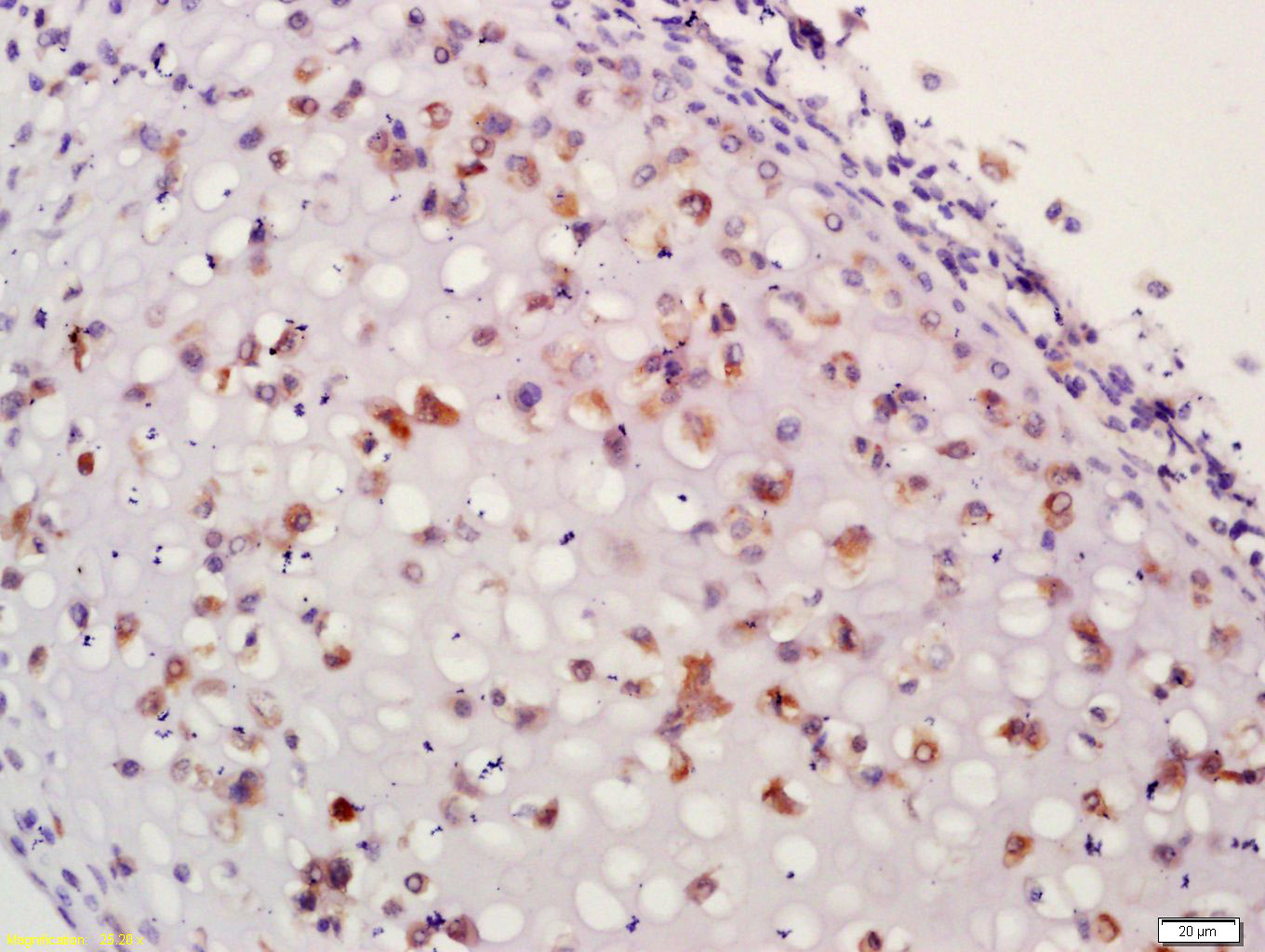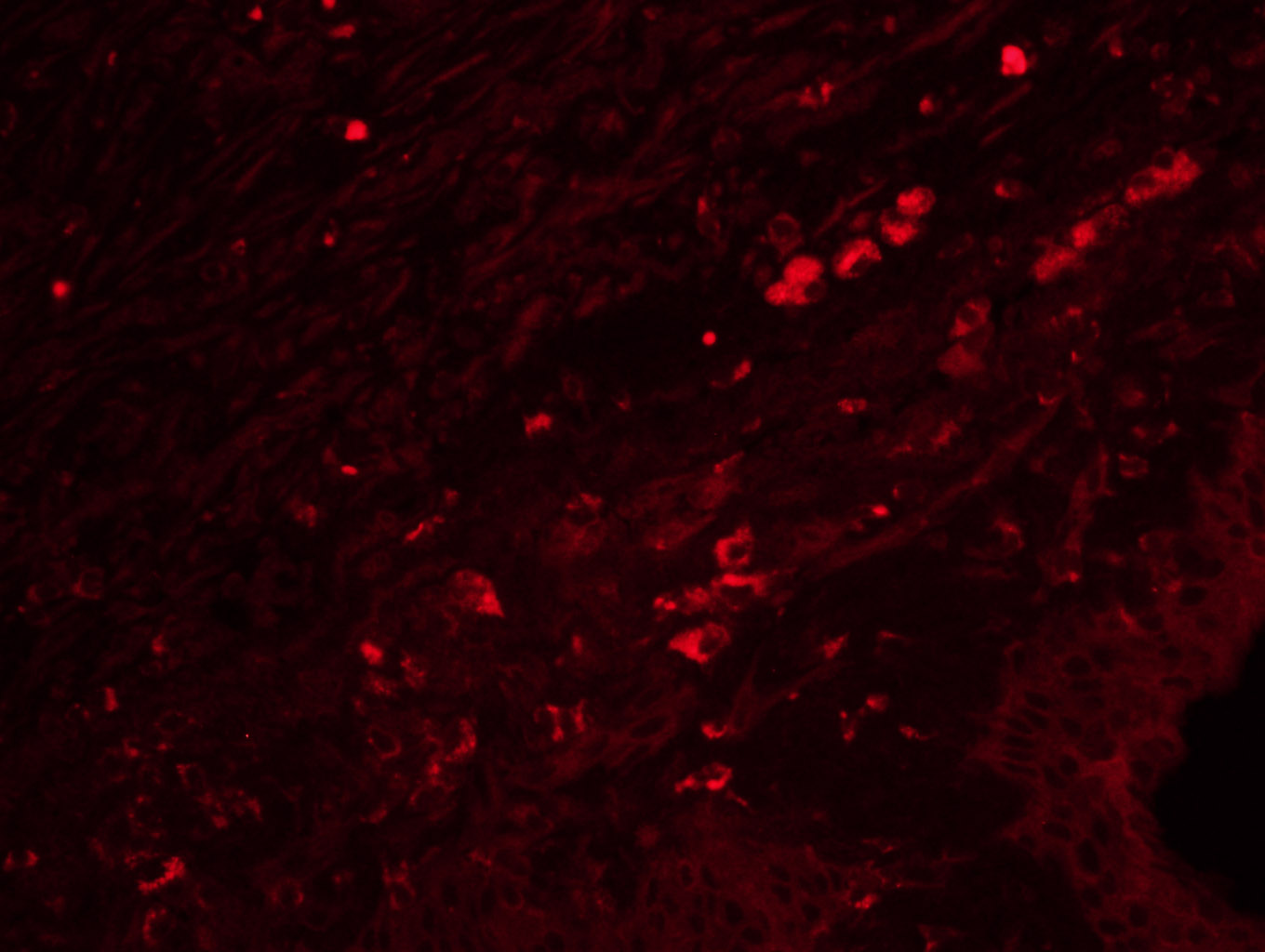
Rabbit Anti-ACAN antibody
Aggrecan; Aggrecan core protein; Cartilage-specific proteoglycan core protein; CSPCP; Chondroitin sulfate proteoglycan core protein 1; Chondroitin sulfate proteoglycan 1; Aggrecan core protein 2; AGC1; CSPG1; MSK16; PGCA_HUMAN.
View History [Clear]
Details
Product Name ACAN Chinese Name 软骨蛋白聚糖抗体 Alias Aggrecan; Aggrecan core protein; Cartilage-specific proteoglycan core protein; CSPCP; Chondroitin sulfate proteoglycan core protein 1; Chondroitin sulfate proteoglycan 1; Aggrecan core protein 2; AGC1; CSPG1; MSK16; PGCA_HUMAN. literatures Research Area immunology Signal transduction Stem cells Immunogen Species Rabbit Clonality Polyclonal React Species Mouse, Rat, (predicted: Human, Chicken, Dog, Pig, Cow, Horse, Rabbit, ) Applications ELISA=1:5000-10000 IHC-P=1:100-500 IHC-F=1:100-500 IF=1:100-500 (Paraffin sections need antigen repair)
not yet tested in other applications.
optimal dilutions/concentrations should be determined by the end user.Theoretical molecular weight 208/248kDa Cellular localization Secretory protein Form Liquid Concentration 1mg/ml immunogen KLH conjugated synthetic peptide derived from human ACAN: 101-220/2415 Lsotype IgG Purification affinity purified by Protein A Buffer Solution 0.01M TBS(pH7.4) with 1% BSA, 0.03% Proclin300 and 50% Glycerol. Storage Shipped at 4℃. Store at -20 °C for one year. Avoid repeated freeze/thaw cycles. Attention This product as supplied is intended for research use only, not for use in human, therapeutic or diagnostic applications. PubMed PubMed Product Detail Aggrecan is a member of a family of large, aggregating proteoglycans (also including versican, brevican and neurocan) which is found in articular cartilage. Aggrecan is composed of three major domains: G1, G2, and G3. Between the G1 and G2 domains there is an interglobulin region (IGD). The IGD region is the major site of cleavage by specific proteases like metalloproteinases (MMPs) and aggrecanase. Aggrecan cleavage has been associated with a number of degenerative diseases including rheumatoid arthritis and osteoarthritis. There is evidence that this family of proteoglycans modulates cell adhesion, migration, and axonal outgrowth in the CNS.
Function:
Aggrecan has been detected in neural precursor cells (neurospheres; Kabos et al, 2004) During differentiation, neurospheres downregulate Chondroitin sulfate proteoglycans (CSPGs). Proliferating neural precursors synthesize lecticans, including aggrecan, which are downregulated with differentiation; suggesting a link between CSPGs and CNS precursor biology.
Subunit:
Interacts with FBLN1. Interacts with COMP.
Subcellular Location:
Secreted, extracellular space, extracellular matrix.
Tissue Specificity:
Restricted to cartilages.
Post-translational modifications:
Contains mostly chondroitin sulfate, but also keratan sulfate chains, N-linked and O-linked oligosaccharides. The release of aggrecan fragments from articular cartilage into the synovial fluid at all stages of human osteoarthritis is the result of cleavage by aggrecanase.
DISEASE:
Spondyloepiphyseal dysplasia type Kimberley (SEDK) [MIM:608361]: Spondyloepiphyseal dysplasias are a heterogeneous group of congenital chondrodysplasias that specifically affect epiphyses and vertebrae. The autosomal dominant SEDK is associated with premature degenerative arthropathy. Note=The disease is caused by mutations affecting the gene represented in this entry.
Spondyloepimetaphyseal dysplasia aggrecan type (SEMD-ACAN) [MIM:612813]: A bone disease characterized by severe short stature, macrocephaly, severe midface hypoplasia, short neck, barrel chest and brachydactyly. The radiological findings comprise long bones with generalized irregular epiphyses with widened metaphyses, especially at the knees, platyspondyly, and multiple cervical-vertebral clefts. Note=The disease is caused by mutations affecting the gene represented in this entry.
Osteochondritis dissecans short stature and early-onset osteoarthritis (OD) [MIM:165800]: A type of osteochondritis defined as a separation of cartilage and subchondral bone from the surrounding tissue, primarily affecting the knee, ankle and elbow joints. It is clinically characterized by multiple osteochondritic lesions in knees and/or hips and/or elbows, disproportionate short stature and early-onset osteoarthritis. Note=The disease is caused by mutations affecting the gene represented in this entry.
Similarity:
Belongs to the aggrecan/versican proteoglycan family.
Contains 1 C-type lectin domain.
Contains 1 EGF-like domain.
Contains 1 Ig-like V-type (immunoglobulin-like) domain.
Contains 4 Link domains.
Contains 1 Sushi (CCP/SCR) domain.
SWISS:
P16112
Gene ID:
176
Database links:
Entrez Gene: 176 Human
Entrez Gene: 11595 Mouse
Omim: 155760 Human
SwissProt: P16112 Human
SwissProt: Q61282 Mouse
Unigene: 2159 Human
Unigene: 358571 Mouse
Unigene: 54503 Rat
Aggrecan是软骨Extracellular matrix的主要结构成分之一。它与Collagen protein网络结合,维持软骨弹性、缓冲压力,承担负荷,并有自我润滑的性能。蛋白多糖的进行性丧失是骨性关节病发病主要原因之一。Product Picture
Antigen retrieval: citrate buffer ( 0.01M, pH 6.0 ), Boiling bathing for 15min; Block endogenous peroxidase by 3% Hydrogen peroxide for 30min; Blocking buffer (normal goat serum,C-0005) at 37鈩� for 20 min;
Incubation: Anti-Aggrecan1 Polyclonal Antibody, Unconjugated(SL1223R) 1:200, overnight at 4掳C, followed by conjugation to the secondary antibody(SP-0023) and DAB(C-0010) staining
Tissue/cell: rat kidney tissue;4% Paraformaldehyde-fixed and paraffin-embedded;
Antigen retrieval: citrate buffer ( 0.01M, pH 6.0 ), Boiling bathing for 15min; Blocking buffer (normal goat serum,C-0005) at 37℃ for 20 min;
Incubation: Anti-Aggrecan1 Polyclonal Antibody, Unconjugated(SL1223R) 1:200, overnight at 4°C; The secondary antibody was Goat Anti-Rabbit IgG, Cy3 conjugated(SL0295G-Cy3)used at 1:200 dilution for 40 minutes at 37°C.
Bought notes(bought amounts latest0)
No one bought this product
User Comment(Total0User Comment Num)
- No comment




 +86 571 56623320
+86 571 56623320
 +86 18668110335
+86 18668110335

